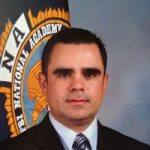By Dr. Jarrod Sadulski, Faculty Member, Criminal Justice, American Military University and Efren Muñoz , Major, Criminal Investigation Directorate and INTERPOL, National Police of Colombia
The National Police of Colombia, a world class policing organization, is on the frontlines of combating narcotics production and trafficking. Recently, through an invitation from Major Efren Muñoz of the National Police of Colombia, American Military University School of Security and Global Studies Program Director Dr. Chuck Russo and I visited Bogotá, D.C., and the National Police of Colombia.
[Related: Colombian National Police: Combating Human and Drug Trafficking]
Thanks to their hospitality, we had the opportunity to conduct research at the Criminal Investigation Directorate and INTERPOL (referred to as DIJIN), the Police Anti-Narcotics Directorate (DIRAN), and the main judicial institution, the General Prosecution Office of the Nation (FISCALIA).
We held research meetings at the General Prosecution Office and Police Anti-Narcotics Directorate, which provided valuable information into the current trends of narcotics trafficking in Colombia and the proactive role that DIJIN and the Police Ant-Narcotics Directorate are taking to combat this problem.
Cocaine Has Been the Engine of the Colombian Internal Armed Conflict
Cocaine in Colombia is something like cancer to humans. Cocaine has been the engine of the Colombian internal armed conflict; it is also the main weapon of criminals to corrupt public officials in all government agencies because of the huge amount of money that criminal organizations amass.
[Related: The Failing Battle Against Drug Production in Colombia]
Cocaine cartels in Colombia have affected many thousands of people. The cartels strengthened guerrilla groups such as FARC and ELN, and other illegal armed groups. They have destroyed the core values of the society so much so that recent generations have been raised within illegal subcultures and taught how to gain easy money in the drug trade. For them, it is better to kill, kidnap, or extort rather than work legitimately for a living.
The Toll of Medellin Cartel Attacks
According to a 2013 article in Revista Semana, the “Cartel de Medellín” committed 623 attacks that left approximately 400 civilians dead and 1,710 injured. A total of 550 police officers were killed by Pablo Escobar, who paid an average of 2 million Colombian pesos for each homicide, or almost $571 U.S. dollars. Between September and December 1989, the Medellin Cartel set off 100 bombs that affected supermarkets, banks, schools, electrical, and telephone installations.
The terrorist attack against the headquarters of the Administrative Security Department (DAS) in Bogotá in 1989, left 70 people dead and 700 injured. In the same year, a bomb onboard a Colombian Avianca Airlines flight killed 111 passengers. Between January and May of 1990 there were 85 bombings against the Cali Cartel-owned Drogas La Rebaja pharmacy chain in Pereira, Cali, Bogotá and Medellin.
In the last 20 years 15,000 people died from bombings and similar acts of violence, according to estimates by the authorities. In sum, combating transnational narcotics trafficking has cost too many sacrifices, too much pain, and thousands of human lives. Obviously, none of this makes Colombians proud. On the contrary, this situation motivates Colombians to continue combating this kind of cancer.
Results of Disbanding Major Cartels
Since the breakup of the notorious transnational Medellin and Cali cartels, there are now over 2,000 small, decentralized drug trafficking organizations in Colombia that are responsible for cocaine and other illicit drug cultivation, manufacturing, and trafficking. The General Prosecution Office has developed a Strategic Counter Narcotics Plan, which includes partnerships with 43 government and non-governmental organizations (NGOs) to reduce cocaine production.
There are 253 routes in Colombia that have been identified for drug transportation. Parts of the country consist of dense jungle where there are no roads. Traffickers have created routes in the jungle that are just one meter (3.3 feet) wide, which are difficult to see from the air.
Large bundles of cocaine are carried into neighboring Panama and Ecuador because, as the Police Anti-Narcotics Directorate explained, it is currently common for cocaine to be shipped more easily out of neighboring countries than from Colombia. As a result, it is common for drug couriers to spend 12 days transiting the Colombian jungle with cocaine. Drug production supplies return into Colombia through these jungle routes.
Certain regions in Colombia are better known for the production or harvesting of certain drugs. For example, Valle del Cauca department is known for its marijuana production.
Planes and Submarines Used to Transport Cocaine
In a presentation by the Police Anti-Narcotics Directorate, we were shown photographs of seized or crashed jets that can carry up to a ton of cocaine. Along Colombia’s southwest coast, small planes often land on the beach at low tide to assist in the drug trafficking process as small boats deliver the narcotics to them.
Interestingly, the size of the jets was consistent with a current trend in Belize, where several suspected cocaine-laden jets have landed on roadways at night and then were abandoned near the Belize-Mexico border.
Colombia’s seven major airports serve 97 countries and as transshipment points for cocaine. Among the nations that the drugs are flown to, Spain currently receives the largest quantities, according to the presentation.
The National Police presentation also discussed the semi-submersible subs that commonly use batteries for propulsion because they do not generate the same amount of heat as traditional engines. That aids in their better concealment. These subs can be built in as little as 60 days.
Dr. Russo and I came away with the knowledge and assurance that the National Police of Colombia — through its DIJIN and its Police Anti-Narcotics Directorate — are utilizing experience, intelligence, strategic initiatives, aircraft, and significant manpower to combat the transnational problem of drug trafficking.
About the Authors:



Comments are closed.